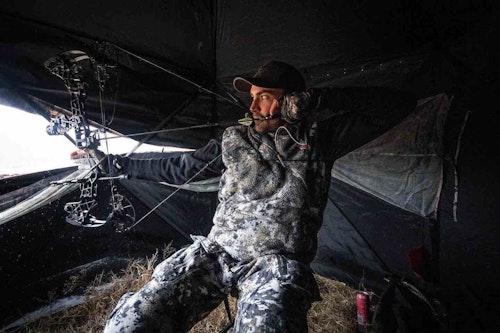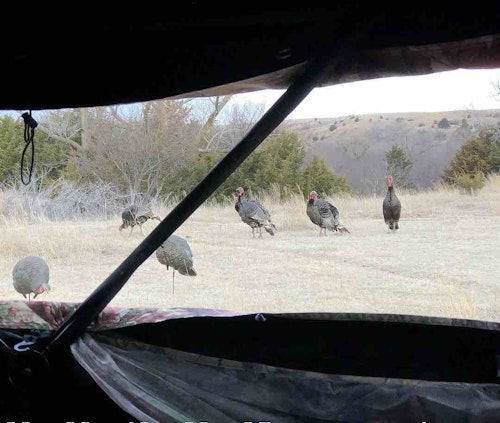If you’re like most archery turkey hunters, you sit in a pop-up ground blind and wait for a gobbler to check out one or more decoys placed nearby. There’s no doubt this is an effective strategy for getting close-range shots at birds.
One problem: These bowhunters rarely — if ever — practice shooting from a chair, they don’t practice drawing their bow and shooting from a pop-up blind’s window, and they don’t verify which sight pin is needed for pinpoint arrow placement at ranges of only 3-10 yards.
Click here to read an article I wrote about choosing sight pins for point-blank shots on turkeys. I think you’ll be surprised to learn why a 30-yard pin is often the right one for a 3-yard shot. Below I’ll cover the issues about shooting from a chair, as well as the specific problems inherent with shooting from a pop-up blind.

Practice While Sitting
As I said earlier, most bowhunters use a pop-up blind to ambush wild turkeys, but unfortunately they don’t practice shooting while sitting. In no particular order, here are some items to consider before a spring turkey bowhunt.
With today’s short-axled compounds, hitting the lower cam of your compound on your knee is rarely a problem for level shots at turkeys, but it pays to find out before a gobbler is standing at 5 yards.
A bigger problem could be your clothing choices. If temperatures are cold and you’re wearing a bulky jacket, does the fabric over your chest and stomach ball up when you’re sitting? Does it interfere with the bowstring? Does the bowstring hit your sleeve? Find out before it really matters.
At times you might have to hold at full-draw for a long time before getting the perfect shot angle on a turkey. Do you tire more easily when holding your bow at full draw sitting vs. standing? And is it more difficult for you to draw your bow while sitting? Again, find out prior to turkey season.
This leads me into the specific issues/problems with shooting from a pop-up blind. Thanks to short-axled compounds, you shouldn’t have a problem hitting your compound’s top cam on the roof of the blind. But if you’re in the habit of holding your bow hand fairly high during the draw, you might.
How far from the window must you sit to have clearance for the arrow tip before you draw? And does your stabilizer hit the front of the blind as you aim? Find out now.
You also want to check whether your chair makes noise as you draw or adjust your position. Even if a turkey can’t see you hidden in the blind, it might hear you. I’ve seen first-hand instances where a hen or two was standing only a foot or two from a blind’s window, and when a tom finally approached at 5 yards and a buddy drew his bow, the chair squeaked, and the hens heard it and then hustled away, taking the tom with them. Another problem comes with aiming and shooting out a blind’s window. If your chair is too low, or the window is too high, your arrow could hit the bottom of the window. Not good! And this problem is greatly increased if you choose a large fixed-blade broadhead such as a 125-grain Magnus Bullhead or a 200-grain Turkey D-Cap; both are designed specifically for head and neck shots on turkeys.

One aspect of pursuing turkeys from a pop-up blind that many hunters fail to consider is where decoys are placed in regards to the windows. Sure, a gobbler will walk or strut wherever he desires, but put the odds in your favor by placing decoys in such a way that maximizes your chance of getting a clear shot.
The only way to get better at shooting arrows from a pop-up blind at live turkeys is practicing from the same blind on targets.








